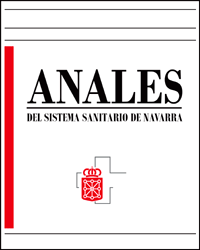Diagnóstico clínico-radiológico de neurocisticercosis: a propósito de un caso
DOI:
https://doi.org/10.23938/ASSN.0166Palabras clave:
Neurocisticercosis. Epilepsia. Inmigrante. Albendazol. Taenia solium.Resumen
Introducción. La neurocisticercosis es la enfermedad parasitaria más frecuente del sistema nervioso central y la primera causa de epilepsia de inicio tardío en las áreas endémicas. Nuestro objetivo con este trabajo es orientar a través de los criterios clínicos y radiológicos el diagnóstico de sospecha de esta enfermedad, presentando un caso clínico. Materiales y métodos. Presentamos el caso de una mujer de 43 años, natural de Bolivia, que acudió al Servicio de Urgencias tras presentar una crisis convulsiva generalizada, presenciada por familiares de la paciente. Resultados. Se realizó una tomografía axial computarizada craneal, que permitió junto con su historia clínica sospechar una neurocisticercosis. Se ingresó en neurocirugía para completar el estudio, que confirmó el diagnóstico de sospecha, y recibió tratamiento con albendazol y corticoides, con buena evolución. Conclusiones. La neurocisticercosis es una patología emergente en países desarrollados, debido al aumento de la inmigración desde áreas endémicas, principalmente de América Latina. La epilepsia es la expresión clínica más frecuente, pero la presentación es muy variable. Un alto grado de sospecha es necesario para poder diagnosticar esta enfermedad.Descargas
Descargas
Publicado
Cómo citar
Número
Sección
Licencia
La revista Anales del Sistema Sanitario de Navarra es publicada por el Departamento de Salud del Gobierno de Navarra (España), quien conserva los derechos patrimoniales (copyright ) sobre el artículo publicado y favorece y permite la difusión del mismo bajo licencia Creative Commons Reconocimiento-CompartirIgual 4.0 Internacional (CC BY-SA 4.0). Esta licencia permite copiar, usar, difundir, transmitir y exponer públicamente el artículo, siempre que siempre que se cite la autoría y la publicación inicial en Anales del Sistema Sanitario de Navarra, y se distinga la existencia de esta licencia de uso.








